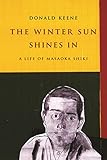The Winter Sun Shines In : A Life of Masaoka Shiki / Donald Keene.
Material type: TextSeries: Asia Perspectives: History, Society, and CulturePublisher: New York, NY : Columbia University Press, [2013]Copyright date: ©2013Description: 1 online resource (240 p.) : ‹B›B&W Photos: ‹/B›14Content type:
TextSeries: Asia Perspectives: History, Society, and CulturePublisher: New York, NY : Columbia University Press, [2013]Copyright date: ©2013Description: 1 online resource (240 p.) : ‹B›B&W Photos: ‹/B›14Content type: - 9780231164887
- 9780231535311
- 895.614 23
- PL811.A83 Z6776 2013
- PL811.A83 Z6776 2015
- online - DeGruyter
- Issued also in print.
| Item type | Current library | Call number | URL | Status | Notes | Barcode | |
|---|---|---|---|---|---|---|---|
 eBook
eBook
|
Biblioteca "Angelicum" Pont. Univ. S.Tommaso d'Aquino Nuvola online | online - DeGruyter (Browse shelf(Opens below)) | Online access | Not for loan (Accesso limitato) | Accesso per gli utenti autorizzati / Access for authorized users | (dgr)9780231535311 |
Frontmatter -- Contents -- Introduction -- 1. The Early Years -- 2. Student Days -- 3. The Song of the Hototogisu -- 4. Shiki the Novelist -- 5. Cathay and the Way Thither -- 6. Sketches from Life -- 7. Hototogisu -- 8. Shiki and the Tanka -- 9. Shintaishi and Kanshi -- 10. Random Essays ( Zuihitsu ), 1 -- 11. Random Essays, 2 -- 12. The Last Days -- Notes -- Bibliography -- Index
restricted access online access with authorization star
http://purl.org/coar/access_right/c_16ec
Rather than resist the vast social and cultural changes sweeping Japan in the nineteenth century, the poet Masaoka Shiki (1867-1902) instead incorporated new Western influences into his country's native haiku and tanka verse. By reinvigorating these traditional forms, Shiki released them from outdated conventions and made them more responsive to newer trends in artistic expression. Altogether, his reforms made the haiku Japan's most influential modern cultural export.Using extensive readings of Shiki's own writings and accounts of the poet by his contemporaries and family, Donald Keene charts Shiki's revolutionary (and often contradictory) experiments with haiku and tanka, a dynamic process that made the survival of these traditional genres possible in a globalizing world. Keene particularly highlights random incidents and encounters in his impressionistic portrait of this tragically young life, moments that elicited significant shifts and discoveries in Shiki's work. The push and pull of a profoundly changing society is vividly felt in Keene's narrative, which also includes sharp observations of other recognizable characters, such as the famous novelist and critic Natsume Soseki. In addition, Keene reflects on his own personal relationship with Shiki's work, further developing the nuanced, deeply felt dimensions of its power.
Issued also in print.
Mode of access: Internet via World Wide Web.
In English.
Description based on online resource; title from PDF title page (publisher's Web site, viewed 02. Mrz 2022)


